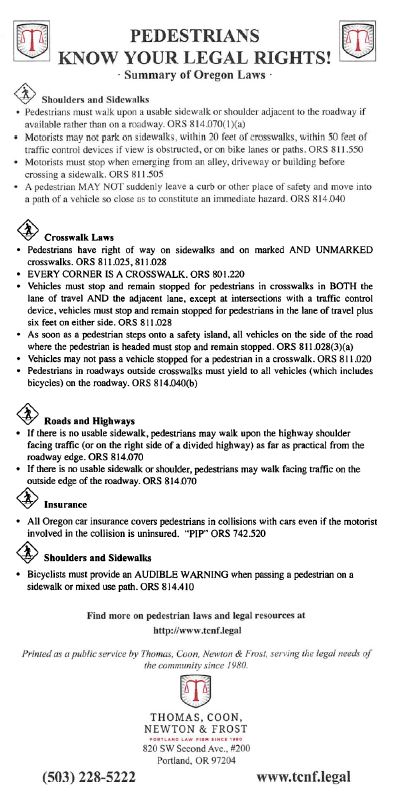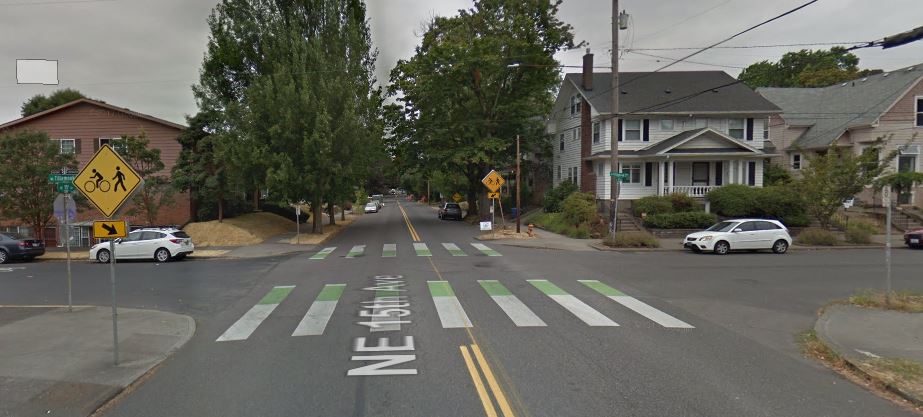A quick reference guide to the legal rights of pedestrians in the state of Oregon, provided by the bike and pedestrian lawyers of Thomas, Coon, Newton & Frost.

Shareable pdf file here.

A quick reference guide to the legal rights of pedestrians in the state of Oregon, provided by the bike and pedestrian lawyers of Thomas, Coon, Newton & Frost.

Shareable pdf file here.
The other day I was driving along Tualatin Valley highway during afternoon rush hour. Both lanes in each direction were filled with cars. As I drove through an area where construction was occurring I saw that the crew had stopped work for the day and left a furled up construction sign on a tripod stand right in the middle of the bike lane. Whoever did it was not thinking about a commuter bicycle rider coming along and having to leave the bike lane and go into heavy traffic to avoid the sign. This sort of thing is all too frequent and is dangerous for everyone, but so are the wider effects of construction sites. Whole neighborhoods can feel the impact of construction on a single street-corner.

All too often bike lanes, multi-use paths and sidewalks are closed to the public far longer than is necessary. The danger to the public increases as pedestrians and bicycle riders scramble to reconfigure themselves into the available spaces to get around the construction zone. This scramble creates deaths and injuries that are foreseeable and avoidable.
The easy fix for these hazards to citizens is to employ good traffic control practices. Most construction sites on roadways have requirements for Traffic Control Plans (TCP). These TCPs must be filed as part of the construction permit process where the public way will be impacted by construction. All too often “traffic control” means setting up a system merely to divert motorized traffic around the construction site. Often this means closing adjacent sidewalks and bike lanes. It is important to protect the public from arbitrary and unnecessary closures of the public way including that of sidewalks and bike lanes by complaining to public officials when dangerous closures occur. And, as in the example provided above, it is imperative for safety that construction companies train workers to remove closures from the public way as early as possible to restore the natural traffic flow and right of way.
Collecting photographs of examples of unnecessarily dangerous public way closures can help raise awareness of these issues and encourage communities to reprioritize and to recognize the importance of non-motorized traffic. In 2016, local advocacy groups The Street Trust and Oregon Walks placed direct pressure on Portland city officials by creating the hashtag #WorkZoneWTF as a way to collect the most glaring examples of closures of the public way on social media. The many examples that flooded in created a graphic collection of the unnecessary hazards created by failing to recognize the rights of non-motorized road users.
After this effort, Portland implemented a city-wide construction traffic policy change in July 2016. The City Council voted 5-0 to adopt a new resolution changing the permitting of TCPs so as to preserve the public way for vulnerable users: “We wanted to make sure the last resort was to close the sidewalk and to close the bike lane,” said Faith Winegarden, the Portland Bureau of Transportation (PBOT) permitting manager. “We want to make sure every option has been explored.” Bike Portland published an article on the policy change which can be found here.
Portland has continued to make good progress in this regard, but the state of Oregon has fallen behind. As part of a biennial Oregon Department of Transportation (ODOT) Work Zone Safety Audit for 2017, ODOT’s reviewers gave some of the lowest scores to bicycle, pedestrian and ADA accommodations like continuous routes through construction zones, signage marking these routes, and ADA compliance. According to ODOT, these low scores mean that these areas “[need] additional attention,” which led them to update their 2018 advisory materials on standard site specifications and TCP design. And there’s more work to be done. ODOT’s plans for 2018 do consider non-motorized road use in urban environments, but more attention should be paid to the needs of non-motorized road users in rural areas. Pedestrian and cyclist traffic still isn’t being afforded the same attention and protection as motorized road use at the state level.
Here are a few of the measures Portland has adopted to limit the effect of construction sites upon pedestrians and cyclists:
These measures might seem like common-sense, and they might seem like the minimum we ought to expect from city policy, but these protections are by no means guaranteed outside of Portland. I hope ODOT will follow PBOT’s lead and implement similar protections statewide.
Portland’s inner eastside contains an extensive network of neighborhood greenways: low traffic side streets that encourage bike traffic by including sharrow pavement markings, bike-specific wayfinding signs, speed bumps, diverters, and fewer stop signs. Examples include NE Going, NE Tillamook, SE Clinton and SE Lincoln. While greenway riding is typically a low key alternative to riding in a bike lane or on the shoulder of high-volume, auto-oriented streets, the crossing of higher speed arterials that cross the greenway can be stressful. At most greenway crossings of arterials, bicyclists face a stop sign and cross traffic flows freely. In an effort to improve arterial crossings, the City has painted green “crossbikes” across the intersection and installed signs warning arterial drivers of the greenway crossing. The NE Tillamook greenway crossing of NE 15th Avenue is shown here:

What, if any, legal authority do these green “crossbikes” confer on greenway bike users? The short answer: none. Despite the similarity in appearance and name to “crosswalk”, a crossbike does not entitle a bicyclist to any of the legal rights enjoyed by a crosswalk user.
Crossbikes do not fall under the legal definition of a crosswalk. A marked crosswalk is defined under ORS 801.220 as “any portion of a roadway at an intersection or elsewhere that is distinctly indicated for pedestrian crossing by lines or other markings on the surface of the roadway.” While crossbikes do constitute roadway markings at an intersection, their location in the roadway demonstrates that they are not intended for “pedestrian crossing.” Therefore, crossbikes are not crosswalks, and crossbike users are not entitled to any of the legal rights of crosswalk users. In fact, crossbikes fail to fall within any statutory definition under Oregon law, making them legally meaningless.
Despite their lack of legal meaning, drivers and bicyclists often treat crossbikes as if they were—as their name suggests—crosswalks for bikes. Under Oregon’s crosswalk law, ORS 811.028, once a pedestrian begins crossing in a crosswalk, approaching drivers must stop and remain stopped until the pedestrian has cleared. Pedestrians can assert this right of way by moving into the roadway with the intent to proceed. Therefore, pedestrians using the white zebra-striped crosswalks in the above photo have the legal right to cause cross traffic to stop simply by stepping into the roadway.
In contrast, bicycle users of the green zebra-striped crossbikes in the above photo have no right to cause cross traffic to stop. Instead, pursuant to ORS 811.260(15), the stop sign they face requires them to stop and yield to cross traffic. However, the similar appearance of the two types of markings, together with the yellow signs indicating bicycle and pedestrian crossing, strongly suggests that arterial traffic must yield to all greenway users. Indeed, the behavior of many arterial drivers and greenway bicyclists demonstrates that, despite the underlying legal rights, crossbikes largely function as crosswalks for practical purposes.
Is there any harm in this inconsistency between the practical use of infrastructure and the underlying legal authority? In many cases, perhaps not. While installing crossbikes didn’t cost the City much (the green paint and signs were presumably relatively inexpensive) and the legal ambiguity may help bicyclists cross arterials more efficiently, there may be higher costs. For example, what if a bicyclist mistakenly assumes that an approaching vehicle is slowing, and rolls past the stop sign into the crossbike? Under Oregon law, the driver would clearly have the right of way, and the result could be a seriously injured bicyclist with no legal recourse because the cyclist was not entitled to the right of way.
Yes, in Oregon, a person can ride a bicycle on a sidewalk even if the street they are riding along has a bicycle lane.
Oregon is a mandatory sidepath law state, which means that the law requires a bicycle operator to use a bicycle lane if one is present instead of riding in the mixed traffic lane. ORS 814.420 Failure to use bicycle lane or path prohibits a person from “operat[ing] a bicycle on any portion of a roadway that is not a bicycle lane or bicycle path when a bicycle lane or bicycle path is adjacent to or near the roadway.”
However, the law only restricts bicycle operators from operating on the roadway when there is a bicycle lane and the sidewalk, while part of the highway, is not part of the roadway. The roadway is “the portion of a highway that is improved, designed or ordinarily used for vehicular travel, exclusive of the shoulder.”
I have been asked by some attendees of our bicycle legal clinics about the legal operation of the crossings along the new Orange Line MAX in Portland, specifically the crossings at SE 12th Avenue and SE 8th Avenue where there are both pedestrian crossing signals and bicycle signals.
At these crossings, if nobody triggers the pedestrian crossing signal by pressing the button then bicyclists get a green bicycle signal but the pedestrian crossing signal remains a red “do not cross” hand.
ORS 814.410(2) Unsafe operation of bicycle on a sidewalk gives bicyclists operating on the sidewalk the same rights and responsibilities as pedestrians.
ORS 814.400 Application of vehicle laws to bicycles gives bicyclists operating on a “public way” (not even on the roadway) the same rights and responsibilities of a any other vehicle operator under the vehicle code.
ORS 814.010(6)(b) Appropriate responses to traffic control devices requires that “[a] pedestrian shall not start to cross the roadway in the direction of a signal showing a Wait or Don’t Walk or any other symbol… indicating that the pedestrian may not proceed.”
However, ORS 811.260(3) Appropriate responses to traffic control devices allows “[a] bicyclist facing a green bicycle signal may proceed straight through or turn right or left unless a sign at that place prohibits either turn.”
So, in the situation described and shown in the photo above, we are left with contradictory signals due to a bicycle’s hybrid legal status as a vehicle beholden to both the vehicle code and pedestrian laws.
ORS 814.020 Failure to obey traffic control device contains an exception for when a pedestrian disobeys a signal at the direction of a police officer, but there is no exception for the direction of a conflicting traffic control device.
Unfortunately this problem does not have an easy legal answer. The laws are in conflict with one another. The only solution is a practical one: press the button to trigger both the green bicycle light and the pedestrian crossing signal.